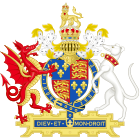Statute of Uses

|
|
| Long title | An Act concerning Uses and Wills. |
|---|---|
| Citation | 27 Hen 8 c 10 |
| Other legislation | |
| Repealed by | Law of Property Act 1925 |
| Relates to |
Statute of Enrolments Statute of Wills |
|
Status: Repealed
|
|
The Statute of Uses (27 Hen 8 c 10) was an Act of the Parliament of England that restricted the application of uses in English property law. The Statute was originally conceived by Henry VIII of England as a way to rectify his financial problems by simplifying the law of uses, which moved land outside the royal tax revenue, traditionally gathered through seisin. His initial efforts, which would remove uses almost completely, were stymied at the 1529 Parliament by members of the House of Commons, many of whom were landowners (who would lose money) and lawyers (who benefited in fees from the confusing law on uses). Academics disagree on how the Commons were brought around, but an eventual set of bills introduced in 1535 was passed by both the Lords and Commons in 1536.
The eventual bills invalidated all uses that did not impose an active duty on trustees, with the beneficiaries of the use being held as the legal owners of the land, meaning they had to pay tax. The Statute partially led to the Pilgrimage of Grace, and more importantly the development of trusts, but academics disagree as to its effectiveness. While most agree that it was important, with Eric Ives writing that "the effect which its provisions had upon the development of English land law was revolutionary", some say that by allowing uses and in certain areas it not only failed to remove the fraudulent element from land law but actively encouraged it.
The common law of England did not provide for a way to dispose of land held by feudal tenure through wills, only urban land, and instead uses were applied, which allowed a landowner to give his land to one or more feoffees, to dispose of it or treat it as the original landowner provided. It was viewed with distrust due to the possibility of abuse; Edward Coke wrote that "there were two Inventors of Uses, Fear and Fraud; Fear in Times of Troubles and civil Wars to save their Inheritances from being forfeited; and Fraud to defeat due Debts, lawful Actions, Wards, Escheats, Mortmains etc". With as many as 13 of such feoffees, there was much confusion over the title to land following a lord's death, as evidenced by the case of Sir John Fastolf, which lasted from 1459 to 1476. While this was a problem that needed correcting, the actual motivation of the Statute was not to do so, but instead to bolster the finances of Henry VIII. For several years prior to the Statute, Henry had been struggling with the need to raise revenue; his royal lands did not provide enough, loans and benevolences would have destroyed his personal popularity; as a result, simply increasing the size of his royal lands was the best option. He turned his attention to land law, arguably the most well developed and complex parts of the common law, and sought to reform it to further his aims. This was well-aimed, since it was uses that were destroying his income; the royal revenue was traditionally gathered through seisin, which uses completely ignored.
...
Wikipedia
